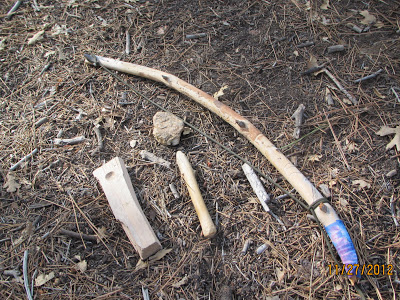It was Thursday afternoon and the last full day of training as I wandered around the forest looking for a strong, curved branch to use as a bow for my bowdrill. My eyes filled with tears and I was pretty sure that I was never going to find one good enough or be able to bust smoke. I had just finished practicing over and over with no success and was now in a right awful mood as seen in my behavior towards my instructor.
This was most definitely the hardest and worst part of training so far, and I had yet to realize why it was so important for teaching.
 If you are unaware of outdoor survival skills you might be asking yourself: Exactly what is a bowdrill? Well, let me tell you: the bowdrill is a set of tools that were originally used by Native Americans to start a fire. The set is composed of a fireboard, a spindle, a top rock or socket rock, and a bow.
If you are unaware of outdoor survival skills you might be asking yourself: Exactly what is a bowdrill? Well, let me tell you: the bowdrill is a set of tools that were originally used by Native Americans to start a fire. The set is composed of a fireboard, a spindle, a top rock or socket rock, and a bow.
The bowdrill creates smoke and hot ash through friction. The top rock presses the spindle down into the fireboard, and the bow is used to rotate the spindle. It is a pretty basic set up, but it is much harder than it looks to actually create fire.
 As instructors at High Trails, we are required to make our own bowdrill set, and we must be able to “bust smoke” in order to teach in the field. On the first day of programs, field instructors introduce the students to the history of the Yuhaviatum Indians, and the ways in which they survived, including how to make a fire with the bowdrill. We also have a class, Native Culture, where the students get to try their own hand at making smoke on these primitive tools.
As instructors at High Trails, we are required to make our own bowdrill set, and we must be able to “bust smoke” in order to teach in the field. On the first day of programs, field instructors introduce the students to the history of the Yuhaviatum Indians, and the ways in which they survived, including how to make a fire with the bowdrill. We also have a class, Native Culture, where the students get to try their own hand at making smoke on these primitive tools.
After many weeks of struggling and practicing, including breaking my bow and having to make a new one, I was finally successful at “busting smoke” and passing the bowdrill test. Through my tears as well as success I have gained a much deeper appreciation for the bowdrill. Not only does “busting smoke” on the bowdrill present a “cool” factor to the students, it represents something much more.
 The bowdrill shows the students that their instructors are not only telling them ways to survive in the wilderness, but could survive themselves if necessary. It shows the students that working hard to achieve something difficult is a life lesson that everyone can benefit from, and also something that young adults have been learning for thousands of years. Now that I can regularly “bust smoke” in the field I not only feel that my hard work has paid off, but I also have a new skill to be proud of.
The bowdrill shows the students that their instructors are not only telling them ways to survive in the wilderness, but could survive themselves if necessary. It shows the students that working hard to achieve something difficult is a life lesson that everyone can benefit from, and also something that young adults have been learning for thousands of years. Now that I can regularly “bust smoke” in the field I not only feel that my hard work has paid off, but I also have a new skill to be proud of.
At High Trails Outdoor Science School, we literally force our instructors to write about elementary outdoor education, teaching outside, learning outside, our dirty classroom (the forest…gosh), environmental science, outdoor science, and all other tree hugging student and kid loving things that keep us engaged, passionate, driven, loving our job, digging our life, and spreading the word to anyone whose attention we can hold for long enough to actually make it through reading this entire sentence. Whew…. www.dirtyclassroom.com

Comments are closed.